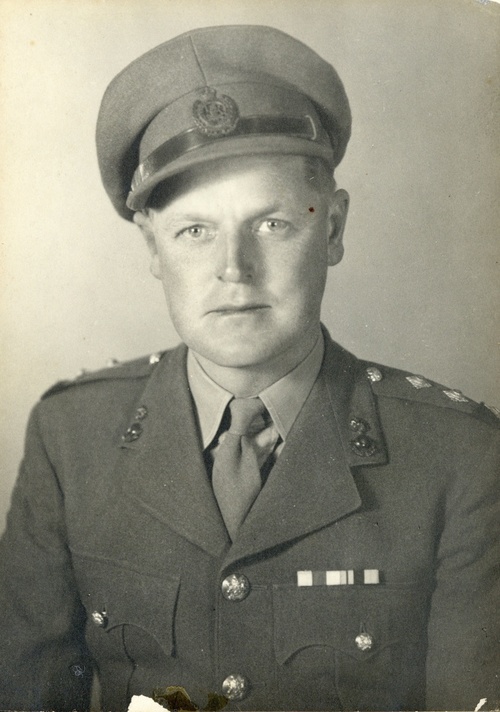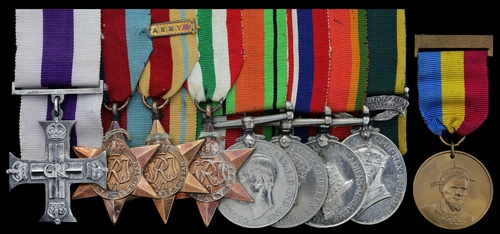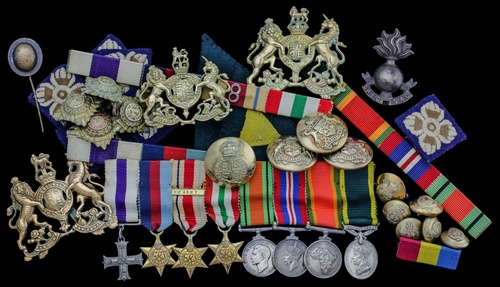Auction: 20001 - Orders, Decorations and Medals - conducted behind closed doors
Lot: 708
(x) Military Cross, G.VI.R., reverse dated '1943'; 1939-45 Star; Africa Star, clasp, 8th Army; Italy Star; Defence and War Medals; Africa Service Medal; Efficiency Medal, G.VI.R., 1st issue, Union of South Africa (Capt. J. H. C. Edmonds - S.A.E.C.); Swaziland, Republic, Independence 1968, bronze, unnamed as issued, the Second World War campaign awards all officially impressed '123659 J. H. C. Edmonds', mounted court-style as worn bar the last, the M.C. detatched, very fine (9)
M.C. London Gazette 14 October 1943. The original recommendation states:
'This Officer, who has been wounded and who escaped from Tobruk, and had been blown up in his truck shortly before, was in charge of a detachment of a section of mine lifting at El Alamein. His courage and leadership was outstanding under heavy fire, and throughout the battle and during the subsequent minefield clearing he was in charge of many hazardous jobs. He was always in the forefront and showed complete disregard for his own safety. Many mined and booby trap areas were cleared by him and he also laid minefields within 100 yards of enemy posts.
His courage has at all times been an inspiration to his men.'
John Harold Courtenay Edmonds was born in Natal and educated at Sevenoaks School, Kent before returning to take up work in Johannesburg. Upon the outbreak of the Second World War he was commissioned from the ranks of the 5th South African Engineering Corps to serve with the 1st and 5th Field Companies. He began his active service attached to the Transvaal Scottish and was known as 'the Sapper Officer with a rather battered cap worn at a rakish angle.'
Having been at Alamein during which he rendered fine work in the minefields, it was at the fall of Tobruk that he came to the fore. A letter dated 19 June 1942 refers:
'Well here we are in a bit of a spot. This will I'm afraid be but a hasty note. We have been informed that our L of C has been cut so we are now a fortress. I think that we will have a somewhat sticky time but then that is to be expected. This will no doubt get to you by sea - should it get to you at all. Life has been rather unpleasant but at the moment we just wait.
I'm afraid that there isn't time for anymore. Regards to you all. I'm afraid that I won't be able to write for some time. I'm detached from my unit and am now with an Indian Brigade.'
It was the 11th Indian Brigade for his unit had been cut off and taken prisoner. His service at the fall of the garrison came through in a latter letter that also refer to his wounds:
'Jack was in Tobruk when she fell and all the news I have of him is from various people who saw him during those days.
When I first saw him he was covered in blood on the face from three wounds on the head, nose and throat and refused medical attention as he said the M/O was too busy. Then they held Jack down and stitched him up.
Story No.2 was from a Capt. Parrott, a grand fellow who told me when he last saw Jack everything has gone wrong. He was in his car and an anti-tank shell from a Jerry tank went slap through Jack's car just behind the driver's seat. Jack took cover in a nearby dugout which received a direct hit and knocked him out when he recovered after a couple of hours his nose was bleeding which accounted for the blood on his face.
I saw one of his brother officers who substantiated this and said "Old Jack did a damn fine job, he's in hospital now I don't think we will see him for some-time. When he eventually left he navigated a tank with a few survivors to safety for a couple of hundred miles across the desert although suffering from concussion."'
From correspondence it was clear his nerves were suffering from what he saw at Tobruk, failing all tests having left hospital. However he begged the Medical Officer to allow him to return to action during the summer of 1942. It seems he had only been returned to his post for three days when the truck he was driving, loaded with explosives and primers caught fire. Edmonds only just managed to escape and flatten himself before they went up. Given his mental state his CO, Colonel Mackenzie took him under his personal charge, whilst the award of the M.C. followed soonafter. This act clearly benefitted Edmonds, for he recovered and was able to play a full role in the operations in Italy towards the end of the War. His name appears twice in Salute the Sappers:
'Edmonds went forward with a troop of 8 Fd Sqn to prepare a site for bridging three canals near Torrente Astrone to open the lateral road to 78 British Division's objective at Citta della Pieve - sporadic mortar fire complicated their task.
Edmonds of 8 Fd Sqn reconnoitred a suitable route through Sienna and up the French Axis for the move on Radda.'
Released from active service on 19 September 1946, Edmonds joined the Colonial Service and studied at Cambridge University. He saw appointments in Northern Rhodesia (Zambia), with his Second War Campaign awards being sent to him at The Boma, Solwezi on 30 May 1951 and latterly in Swaziland, being in receipt of the scarce award of the Independence Medal. A dedicated trout fisherman in retirement, Edmonds died at Kloof, Natal on 6 October 1982.
Sold together with an original archive comprising:
(i)
Portrait photograph.
(ii)
Two telegrams and letters related to his Military Cross and service.
(iii)
Discharge certificate, confirmation of Campaign Awards and distribution letter.
(iv)
Newspaper cuttings and typed obituary.
(v)
Related miniature awards, riband bars, buttons, cloth and metal rank insignia.
Subject to 5% tax on Hammer Price in addition to 20% VAT on Buyer’s Premium. For more information please view Terms and Conditions for Buyers.
Sold for
£2,900
Starting price
£1000









